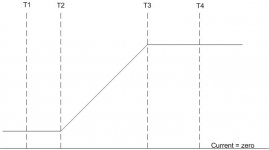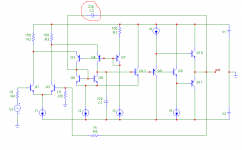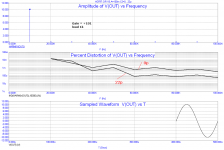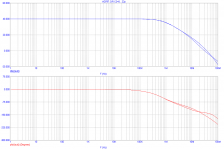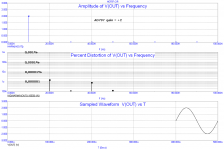We have a very sadist proverb in France: "The best is the ennemy of the good".
It use to turn in circle in your brain each time you broke some near perfect stuff, trying to do better, mixed with a nice sample of your best insults.
Here it's.
Perfection is the enemy of production.
jn
It's amazing what you can discover when you connect a 200MHz bandwidth scope to an amplifier . . .
Noooo... now I want to upgrade my 'scope too
That is your assertion. The paper does not say that, and it would not say that because (I assume) the authors are well aware that the resistance they have calculated is time independent. They have not calculated a time-averaged resistance. You keep claiming that they have. This is false. The similar calculation for skin effect (see any decent EM textbook) does not calculate an average resistance; just a resistance. The maths includes no time averaging.jneutron said:The point is, the specific reason for the paper under discussion (as well as others) was to derive an expression which allows engineers to use a generic factor to calculate the dissipation within a conductor of some geometry, this paper ends with a Rac/Rdc value.
Agreed. But a correct paper cannot calculate something which does not exist, and is unlikely to say that this is the case if it is general knowledge in the relevant field that this is the case. The absence of a note saying "we didn't do X" is not evidence that they could have done X but chose not to; it is (slightly) more consistent with not doing X because X is impossible or meaningless.And as you well know, stating that a paper doesn't derive an entity certainly does not prove it doesn't exist.
Find me a textbook with time varying resistance from skin effect in an ohmic conductor. You can't, because it doesn't exist.Historically, that is incorrect. Unfortunately, I've no clue as to how to redo the equations with infinite conductivity.
I wish we were having this argument 30 years ago. Then I would have attempted what you are asking. My maths is now too rusty. What I can say is that assuming a sinusoidal variation at a single frequency for all fields and currents (which necessarily assumes a time-invarying resistance i.e. fixed geometry) leads to a solution of Maxwell's equations. When a forcing function (e.g. an imposed current) is present you can't arbitrarily add other stuff to the solution, apart from unconnected stuff such as incoming or outgoing waves at other random frequencies, so the solution that had been found is unique. No fiddling, no time-averaging, no double frequency resistance variation. What is found is that the spatial variation in current density amplitude is a function of geometry, material properties and frequency alone; the applied current/field amplitude appears only as an overall multiplying factor. There is no reason to do anything else because Maxwell's equations are linear. Resistors are (almost) linear. All the relevant equations are linear, so there is nothing to generate any harmonics. Nobody has 'tried', in the same way that nobody has tried to calculate things assuming that 2=3 - it is known that it is not true. People don't look for non-linear effects in linear equations; they would be laughed at by anyone who knows any maths. You really must grasp the mathematically ridiculous thing you are asserting.Perhaps you could modify the paper's equations to demonstrate the impossibility? Or will you continue to state it doesn't exist because nobody's tried?
You are asking a time-based question of a frequency-based phenomenon. The DC component of the waveform will always see the DC resistance value. The 1MHz component of the waveform will always see the 1MHz resistance value etc. We are getting into YAFD! I remind you that the audio measurements used a sine wave drive, so questions about square waves are a diversion. If you want to consider square waves, then use Fourier and superposition as I said in an earlier post. We are talking, in effect, of linear filtering not nonlinear distortion production.Within the bridge setup...If a square wave with a specific slew rate is driven into the bridge (for ease in discussion), what is the end terminal resistance value and voltage drop during the ramp up..then, what is the value during ramp down? How long after ramp will the resistor value be it's dc value?
I have had enough of this. I am sure it is boring others, who may (wrongly) believe they are viewing a debate. This is not a debate; it is a failed attempt at teaching 2nd year physics (3rd year EE?) to someone who has picked up a misconception somewhere along the way. I have nothing more to say on this subject. Sorry!
Max, I think your question on the sonic differences between steel and aluminum is valid, but I don't have any evidence to prove it directly, except my experience.
I try to suggest to others what I have found over decades of designing audio products. Once, decades ago, I used sheet steel, almost exclusively: Cheap, malleable, good shield, can look pretty good with a good paint job.
Then I worked with a business partner who preferred aluminum cases, in this instance, Vendetta Research products. Found success with these enclosures, easily finished, light, easy to work with, non-magnetic, etc.
Later, working with another business partner, Bob Crump, I came to realize that we could REPLACE steel with aluminum and get better sonic results. We started this by modifying Parasound power amps, as best as we could, and we got great improvements.
Now, I just specify aluminum, because it sounds better in listening comparisons.
I try to suggest to others what I have found over decades of designing audio products. Once, decades ago, I used sheet steel, almost exclusively: Cheap, malleable, good shield, can look pretty good with a good paint job.
Then I worked with a business partner who preferred aluminum cases, in this instance, Vendetta Research products. Found success with these enclosures, easily finished, light, easy to work with, non-magnetic, etc.
Later, working with another business partner, Bob Crump, I came to realize that we could REPLACE steel with aluminum and get better sonic results. We started this by modifying Parasound power amps, as best as we could, and we got great improvements.
Now, I just specify aluminum, because it sounds better in listening comparisons.
Darn. Mine too.I wish we were having this argument 30 years ago. Then I would have attempted what you are asking. My maths is now too rusty.
Unfortunately, I messed up the problem statement in the last post, so I clarify here.
Given the bridge set to produce proximity effects on a tubular resistor....and the current waveform as shown..
The resistance at time T1 is equal to R, as it is assumed the signal has been there a long time.
During the ramp, what is the value of the resistance between time T2 and T3 as seen by the end terminals?
What is the resistance at time T4, after the current has stopped moving?
Do as you wish..it's certainly not boring others, but if this is the excuse you choose to use to back out, fine..your questioning nature will be missed.I have had enough of this. I am sure it is boring others, who may (wrongly) believe they are viewing a debate. This is not a debate; it is a failed attempt at teaching 2nd year physics (3rd year EE?) to someone who has picked up a misconception somewhere along the way. I have nothing more to say on this subject. Sorry!
jn
Attachments
Last edited:
Hofer found some distoriton in his AP sine generator when the steel cover was put in place - the production fix was to add patch of Al sheet to the steel cover over the oscillator region
the Eddy Current "shielding" of the Al sheet knocks down the B reaching the steel
a inverted application of what Ott, others show for severe EMI shielding by layering high conductivity and high mu materials - the Eddy current in the conducive material "shields" (or reflects) anything more than a few skin depth in frequency content, the iron can short out lower frequency that gets through
so maybe audiophiles need to line their steel boxes with thick Al
the Eddy Current "shielding" of the Al sheet knocks down the B reaching the steel
a inverted application of what Ott, others show for severe EMI shielding by layering high conductivity and high mu materials - the Eddy current in the conducive material "shields" (or reflects) anything more than a few skin depth in frequency content, the iron can short out lower frequency that gets through
so maybe audiophiles need to line their steel boxes with thick Al
My initial question is more to do with measurement data showing spectral and distortion harmonics differences imparted by otherwise identical steel or aluminium enclosures....anybody quantified this ?.
That's an easy one. I have seen unacceptable measurements with internal
signal cable close to a steel chassis. One famous DAC manufacturer (no longer
in business) had this problem. Move the conductor away from the surface,
and the distortion went away. Informed of this, did famous DAC manufacturer
move the cable?
No.
Hofer found some distoriton in his AP sine generator when the steel cover was put in place - the production fix was to add patch of Al sheet to the steel cover over the oscillator region
the Eddy Current "shielding" of the Al sheet knocks down the B reaching the steel
a inverted application of what Ott, others show for severe EMI shielding by layering high conductivity and high mu materials - the Eddy current in the conducive material "shields" (or reflects) anything more than a few skin depth in frequency content, the iron can short out lower frequency that gets through
so maybe audiophiles need to line their steel boxes with thick Al
Hofer, and his employee in charge of the development at the time, Duke Aguiar, also went through some gyrations to reduce distortion in the passive switchmode amp filter box, the AUX0025, including careful inductor choices and, again, use of aluminum for the enclosure.
Isn't there supposed to an "L" some where in Duke's last name?Duke Aguiar
Nope. His ancestry is Hawaiian.Isn't there supposed to an "L" some where in Duke's last name?
Oh, okay. I thought it was a mistype of Duke Aguilar, an engineer I know.Nope. His ancestry is Hawaiian.
"Great" ?I came to realize that we could REPLACE steel with aluminum and get better sonic results. ...and we got great improvements.
So, you pretend that replacing steel with aluminum in any electronic device give an improvement that everybody can hear in blind test ?
The only engineer you are likely to know is Duke Aguiar. Don't worry, he's used to the error.Oh, okay. I thought it was a mistype of Duke Aguilar, an engineer I know.
Viz., this guy: http://www.linkedin.com/pub/duke-aguiar/2/320/5a9
Last edited:
John, my experience is the same than Nelson's one: Moving-away wires, printed boards, and even transfo 1 or 2 centimeters away from steel boxes surfaces usually solve the problem. No mystery.Nope, just me.
That's him! Gotta' get my head straight!The only engineer you are likely to know is Duke Aguiar. Don't worry, he's used to the error.
Viz., this guy: Duke Aguiar | LinkedIn

As I say, he's used to it. I had it wrong for an age myself.That's him! Gotta' get my head straight!
- Status
- Not open for further replies.
- Home
- Member Areas
- The Lounge
- John Curl's Blowtorch preamplifier part II
